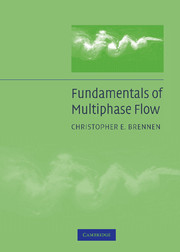Book contents
- Frontmatter
- Contents
- Preface
- Nomenclature
- 1 Introduction to Multiphase Flow
- 2 Single-Particle Motion
- 3 Bubble or Droplet Translation
- 4 Bubble Growth and Collapse
- 5 Cavitation
- 6 Boiling and Condensation
- 7 Flow Patterns
- 8 Internal Flow Energy Conversion
- 9 Homogeneous Flows
- 10 Flows with Bubble Dynamics
- 11 Flows with Gas Dynamics
- 12 Sprays
- 13 Granular Flows
- 14 Drift Flux Models
- 15 System Instabilities
- 16 Kinematic Waves
- Bibliography
- Index
3 - Bubble or Droplet Translation
Published online by Cambridge University Press: 05 June 2014
- Frontmatter
- Contents
- Preface
- Nomenclature
- 1 Introduction to Multiphase Flow
- 2 Single-Particle Motion
- 3 Bubble or Droplet Translation
- 4 Bubble Growth and Collapse
- 5 Cavitation
- 6 Boiling and Condensation
- 7 Flow Patterns
- 8 Internal Flow Energy Conversion
- 9 Homogeneous Flows
- 10 Flows with Bubble Dynamics
- 11 Flows with Gas Dynamics
- 12 Sprays
- 13 Granular Flows
- 14 Drift Flux Models
- 15 System Instabilities
- 16 Kinematic Waves
- Bibliography
- Index
Summary
Introduction
In Chapter 2 it was assumed that the particles were rigid and therefore not deformed, fissioned, or otherwise modified by the flow. However, there are many instances in which the particles that comprise the disperse phase are radically modified by the forces imposed by the continuous phase. Sometimes those modifications are radical enough to, in turn, affect the flow of the continuous phase. For example, the shear rates in the continuous phase may be sufficient to cause fission of the particles and this, in turn, may reduce the relative motion and therefore alter the global extent of phase separation in the flow.
The purpose of this chapter is to identify additional phenomena and issues that arise when the translating disperse phase consists of deformable particles, namely bubbles, droplets, or fissionable solid grains.
Deformation due to Translation
Dimensional Analysis
Because the fluid stresses due to translation may deform the bubbles, drops, or deformable solid particles that make up the disperse phase, we should consider not only the parameters governing the deformation but also the consequences in terms of the translation velocity and the shape. We concentrate here on bubbles and drops in which surface tension, S, acts as the force restraining deformation. However, the reader will realize that there would exist a similar analysis for deformable elastic particles. Furthermore, the discussion is limited to the case of steady translation, caused by gravity, g. Clearly the results could be extended to cover translation due to fluid acceleration by using an effective value of g as indicated in Section 2.4.2.
- Type
- Chapter
- Information
- Fundamentals of Multiphase Flow , pp. 60 - 72Publisher: Cambridge University PressPrint publication year: 2005



